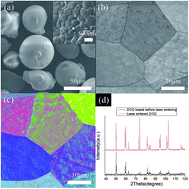Assembled nano-structures from micron-sized precursors
Abstract
Oriented assembly of small crystals to form larger structures are common in nature and full understanding and control of such process would be beneficial for the forthcoming nano-technologies. Such bottom-up assembly of nano-structures most often requires a precursor of nano-sized crystals. Here we demonstrate a novel laser sintering process that can rupture a submicron-sized zirconia precursor into nano-sized crystals, followed by a rapid oriented assembly of these small crystals. A detailed structure study has been carried out to understand the complex process and a model has been proposed. Such a process sheds light on a new way of fabricating nano-materials using commercialized oxide materials.


 Please wait while we load your content...
Please wait while we load your content...